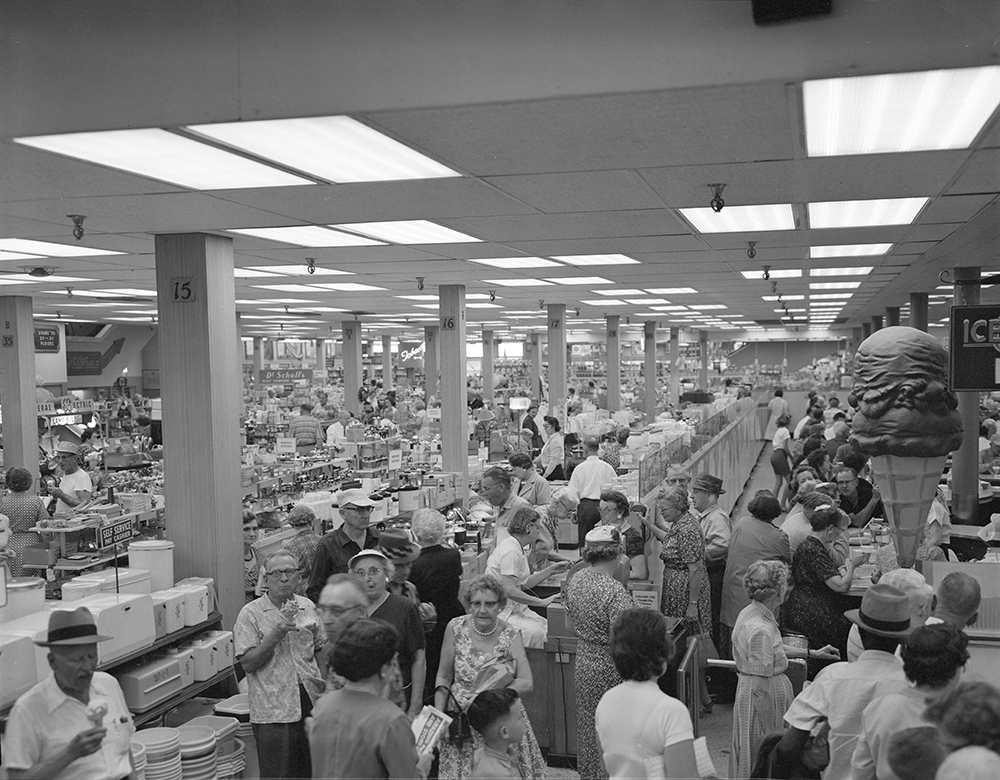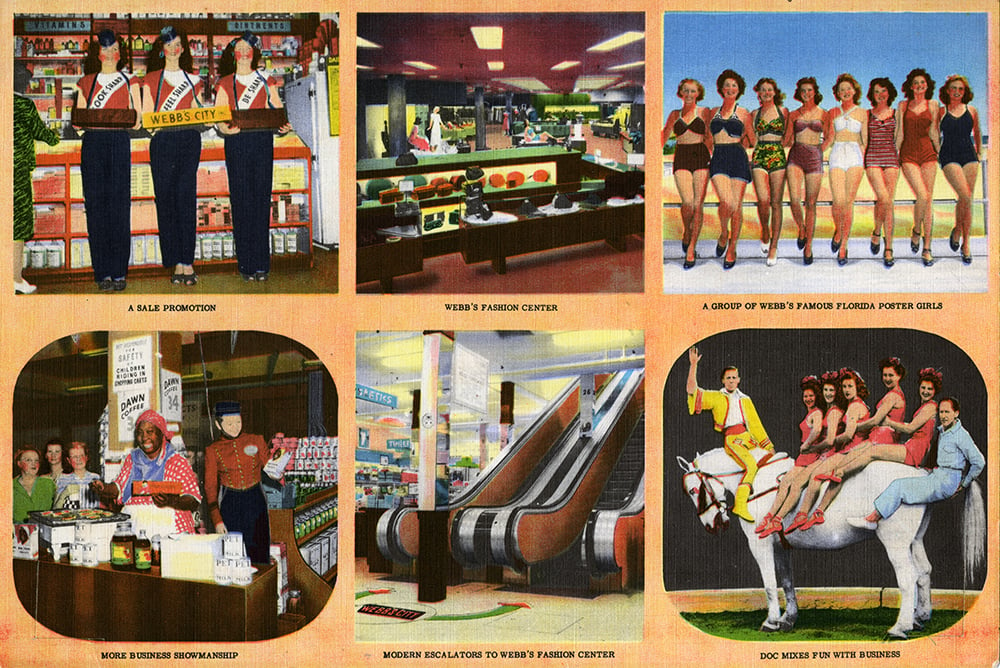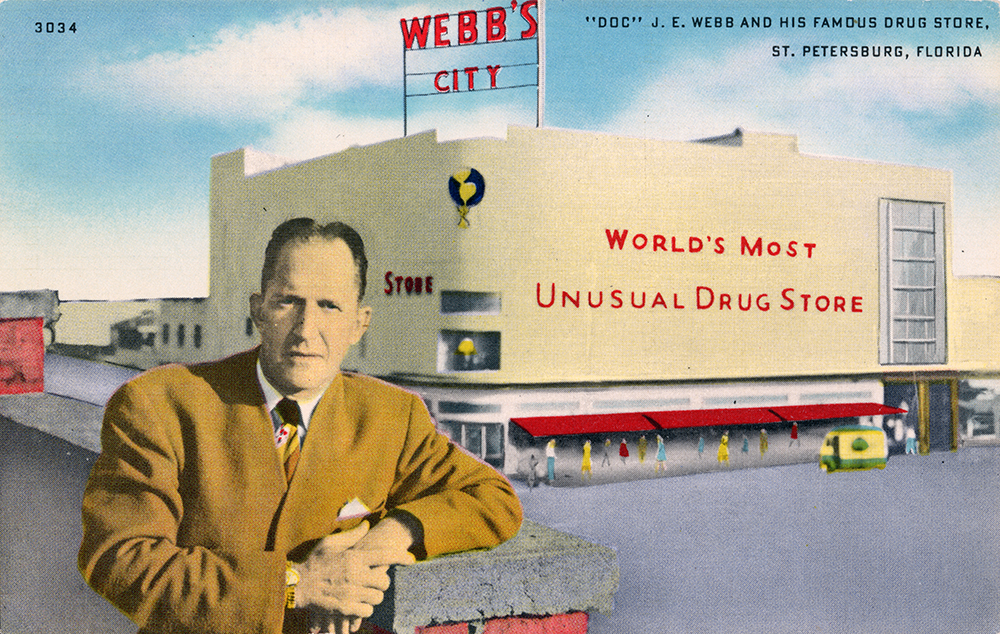For the first issue of this magazine (Vol. 1, Issue 1, September 2016) I wrote about a visit to St. Petersburg in the mid ‘50s as a teenager. While here we visited Webb’s City. I recall entering a very crowded store holding my mother’s hand to make sure we didn’t get separated in the sea of people that seemed to push us along.
This store was unlike anything I had ever seen. There was a lunch counter and the aisles seemed endless—groceries to clothing to hardware, even sideshow acts featuring talking mermaids.
Despite the circus-like atmosphere, what stands out the most to me were two water fountains with signs that read “White Only” and “Colored Only”. As a kid from New York City, I never had any actual experience with segregation. This was the deep south though—at a time when Jim Crow laws and customs were in full effect. In New York my school was a veritable U.N with children of all ethnicities. Perhaps I was just sheltered.

“Webb’s Cut Rate Drug Store”
James Earl “Doc” Webb was born the son of a paving contractor in Nashville, TN. His experience with economic adversity informed his future success. In St. Petersburg and the Florida Dream, author Ray Arsenault explains that, “by the age of twenty, he had become ‘Doc’ Webb — the slick-talking purveyor of patent medicines, magical herbs, and good cheer.”
In 1925, Webb was contacted by an old friend, Hayworth Johnson, who asked him to invest in a small pharmacy he had opened on the outskirts of a predominantly black neighborhood in St. Petersburg Florida was booming and Webb was eager to take advantage of the offer, buying into a 480 sq. ft. drugstore located on the corner of 9th St. S. (now Dr. Martin Luther King Jr. St. S.) and 2nd Ave.
In 1926, Florida’s housing market collapsed sending the state into an economic depression. This didn’t deter Doc Webb though. He bought out his deflated partner and renamed the store “Webb’s Cut Rate Drug Store”.
When it came to merchandising, Doc Webb believed “stack it high and sell it cheap” was the way to increase sales. In some cases his prices were too low and he was sued by companies that had fixed, “fair trade”, pricing. He would ultimately win in Supreme Court, and although he and his customers claimed victory, competitors saw him as a real problem.

19–?. Color souvenir viewbook. State Archives of Florida, Florida Memory.
Doc Webb “the little man’s friend”
Years later, Webb explained “I didn’t care a damn about money. I wanted customers”. This fueled his success. He guaranteed his prices were at least 10% less than his competitors. Through the Great Depression and most of the ‘40s and ‘50s, if you lived in St. Pete, Webb’s City was the place to go for just about everything.
At its peak, Webb’s City had seventy-seven departments in about six square city blocks between 7th and 10th Sts. S. His empire offered furniture, hardware, clothing and gifts, and featured a beauty salon, butcher shop, travel agency, soda fountains, and coffee shops. There was even an Arthur Murray dance studio on the roof. Webb is also credited with creating the “ten item or less” express lane.
Mermaids, Chimps, and Dancing Chickens
When low prices and selection weren’t enough, Doc got resourceful. His promotions included dollar bills for ninety-five cents and breakfast for two cents. He flaunted mermaids, chimp acts, baseball-playing ducks and “dancing” chickens. According to some, the chickens danced because the floor was electrified anytime the button on their display was pushed. But there is no evidence for this. It is likely the chickens were trained with food.*
By the ‘60s though, Doc Webb’s customer base had shifted to predominantly black and senior citizens. Despite this patronage, black customers were still not allowed to shop in all of the clothing departments or eat at the lunch counter. That, combined with the fact that most of the cashiers were white, resulted in the NAACP picketing the store and holding sit-ins. Webb eventually took legal action, claiming the demonstrations were hurting his business. It would turn out to be an uphill battle and just one of many appearances in court for Mr. Webb.
The opening of Tyrone Mall in 1972 was the beginning of the end for Webb’s City. Webb’s low prices and gimmicks weren’t enough to save it as customers started to vanish — preferring to shop at Tyrone and other new shopping centers. Not even a federal loan could keep the “World’s Most Unusual Drug Store” open. Doc Webb sold the store in 1974. In August of 1979 Webb’s City closed for good.

Gone but not forgotten
Doc Webb and his city left an indelible mark on St. Pete’s history and continue to influence our culture today. Talking mermaids live on in events hosted by the St. Petersburg Museum of History. The Webb’s City phenomenon was even turned into a musical staged at the Mahaffey Theater and Ruth Eckerd Hall in 2000. The show was resurrected in a concert version at the Palladium Theater on September 21, 2018. If it should return for another bow, it would be well worth your time to get a taste of the spectacle that was Webb’s City.
Publishers note: Doc Webb continues to make headlines. A debate about historic designation of his one-time home in Allendale has raised issues with St. Pete’s designation process as well as questions about property owners’ rights. At press time, his former home has been recommended for partial designation by the St. Petersburg Development Review Commission (DRC). City Council is expected to have the final say sometime this month.
May 10th, 2019: City Council denied historic designation. Read more in the Tampa Bay Times https://www.tampabay.com/st-petersburg/doc-webb-house-cleared-for-demolition-after-st-pete-city-council-rejects-historic-status-20190510/
May 20th, 2019: A previous version of this story stated that the chickens danced due to electrocution. This likely a myth and the chickens were actually trained with food.




The chicken was not electrocuted or on a hot plate. For anyone who is confused on how this works, the chicken was taught to do its natural digging behavior over and over while the music played in exchange for food/treats. It was also taught that it could pull the string on the piano to start the music if it wanted to dance for food, so if it didn’t want to, it wouldn’t. It’s not being forced to go in and dance, it chooses to. It pulls the string on the piano, its little music starts, and it digs for food, when the music stops, the treats come out.
Hi, William. Thanks for pointing this out. I was able to confirm this with the history museum. You are correct, that is likely a myth. The story has been updated online. We will also print a correction in our next issue. – Ashley
[…] Vol. 4, Issue 5, May 2019 Webb’s City story stated that the chickens danced due to electrocution. However, this was likely a myth and the […]